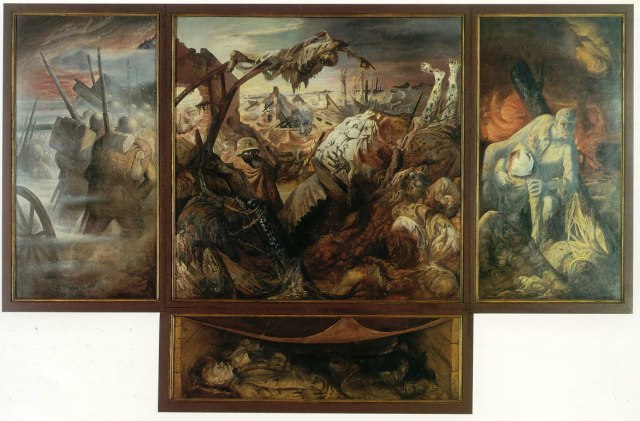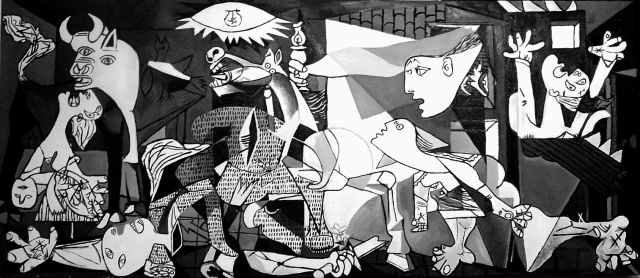
Otto Dix was a German soldier who started painting after the first World War in the 1920’s. He is best known for his satirical portraiture that became a reflection of his haunted perspective and experience of war. Many artists at the time had abandoned traditional and realistic figurative painting but despite this trend Dix found that this style of painting helped him communicate the scenes of war he desired to critique in his art. Although he stuck to a more traditional figurative way of painting Dix was able to gain recognition by the allegorical way he represented ideas of the human condition. For example, we would often use prostitutes and injured war veterans as symbols of a larger humanity that is broken morally and physically.
Triptychon Der Krieg (or War Triptych) shows the narrative of war. The far left panel shows soldiers entering battle, the middle panel, the battlefield, the far right, shows soldiers emerging from war, and the bottom panel displays the ones who lost their lives. My first observation of this triptych was that it seems Dix is depicting a cycle by the way the figures and composition leads the viewers eyes in a circular motion through each of the panels. This makes the statement that war and the death and devastation are a never ending cycle that mankind is trapped in. This is perhaps why the soldier on the far right panel doesn’t necessarily look like he has been liberated from the war because he knows it will always continue and always be with him.

One of Picasso’s most famous works, Guernica depicts the innocent civilian lives lost in the casual bombing practices in the town of Guernica. This painting has since become a symbol and remainder of all tragedies in warfare.
Interpretations of the symbolism used on this painting are widely disputed. One feature that most agree on is that the greyscale tones were used to dramatize the image. I also think that the tones resemble a newspaper print. Although truth is relative, we tend to correlate truth and real events with the news media. Perhaps Picasso wanted to illustrate that this event in this small town that many did not know about, actually occurred and it is important for us to know this. There is much dispute over Picasso’s use of the bull and the horse in this painting. Both hold significance in Spanish culture and have been used by the artist to represent various ideas throughout his work. A common interpretation for this painting is that the bull represents Fascism and the horse, the people of Guernica.
Both of these works depict the horrors of war but focus on slightly different groups of victims. The Dix painting is set in the outdoors, the battlefield. One would argue this setting is somewhat of a public space one where strangers encounter strangers and of course these subjects are soldiers, the ones we expect to be effected by war. Although we expect this, Dix still makes clear that this is a horrific theme in humanity and by showing the faces and looks of distraught in the soldiers’ expressions, he brings to our attention that every soldier is a victim of the evil that is war itself.
Picasso’s painting with the lamp above the figures and the windows suggest that this scene is inside. These references of domesticity bring to light the reality that war does not only effect the ones who decide or are chosen to participate and fight, the horrors of war happen to the average citizen. The innocent civilian attempting to live in peace.

I like how in Dix’s triptych you talk about each section separately, rather than as a whole because i believe the four different sections give a narrative of what battle would be like. I also enjoy reading your interpretation on Guernica and the figures being shown, because as you say they can be seen in many ways, and individuals take different meanings from the allegorical figures.
LikeLike